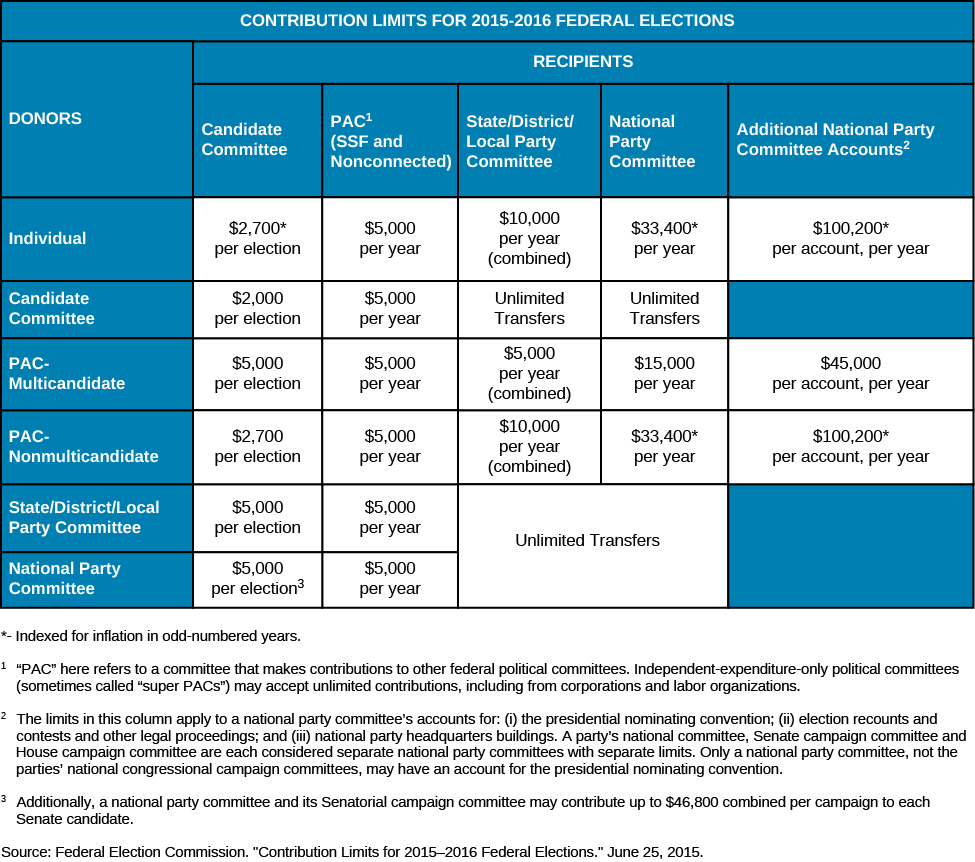| << Chapter < Page | Chapter >> Page > |
Several limits on campaign contributions have been upheld by the courts and remain in place. Individuals may contribute up to $2,700 per candidate per election. This means a teacher living in Nebraska may contribute $2,700 to Bernie Sanders for his campaign to become to the Democratic presidential nominee, and if Sanders becomes the nominee, the teacher may contribute another $2,700 to his general election campaign. Individuals may also give $5,000 to political action committees and $33,400 to a national party committee. PACs that contribute to more than one candidate are permitted to contribute $5,000 per candidate per election, and up to $15,000 to a national party. PACs created to give money to only one candidate are limited to only $2,700 per candidate, however (
[link] ).

Although the Constitution explains how candidates for national office are elected, it is silent on how those candidates are nominated. Political parties have taken on the role of promoting nominees for offices, such as the presidency and seats in the Senate and the House of Representatives. Because there are no national guidelines, there is much variation in the nomination process. States pass election laws and regulations, choose the selection method for party nominees, and schedule the election, but the process also greatly depends on the candidates and the political parties.
States, through their legislatures, often influence the nomination method by paying for an election to help parties identify the nominee the voters prefer. Many states fund elections because they can hold several nomination races at once. In 2012, many voters had to choose a presidential nominee, U.S. Senate nominee, House of Representatives nominee, and state-level legislature nominee for their parties.
The most common method of picking a party nominee for state, local, and presidential contests is the primary. Party members use a ballot to indicate which candidate they desire for the party nominee. Despite the ease of voting using a ballot, primary elections have a number of rules and variations that can still cause confusion for citizens. In a closed primary , only members of the political party selecting nominees may vote. A registered Green Party member, for example, is not allowed to vote in the Republican or Democratic primary. Parties prefer this method, because it ensures the nominee is picked by voters who legitimately support the party. An open primary allows all voters to vote. In this system, a Green Party member is allowed to pick either a Democratic or Republican ballot when voting.
For state-level office nominations, or the nomination of a U.S. Senator or House member, some states use the top-two primary method. A
top-two primary , sometimes called a jungle primary, pits all candidates against each other, regardless of party affiliation. The two candidates with the most votes become the final candidates for the general election. Thus, two candidates from the same party could run against each other in the general election. In one California congressional district, for example, four Democrats and two Republicans all ran against one another in the June 2012 primary. The two Republicans received the most votes, so they ran against one another in the general election in November.

Notification Switch
Would you like to follow the 'American government' conversation and receive update notifications?